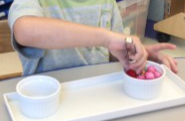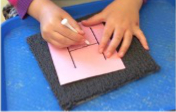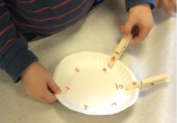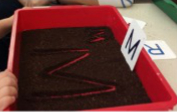Children Want to Draw and Write
From a young age, children understand that drawings, writing and images are used to communicate and convey meaning. Many young children often begin making marks (writing) as soon as they can hold a crayon and often ask their adults to ‘read’ their writing. Children understand that adults use writing every day to text friends, make grocery lists, and write notes. Encouraging children to view themselves as writers supports positive writing attitudes as children grow.
The Importance of a Dedicated Writing Center
Writing Centers have opportunities for fine motor activities, which allow children to develop hand, finger and wrist strength, hand-eye coordination, visual perception, and upper body strength. By having materials ready for children to compose pictures, lists, notes, cards, and books, Writing Centers support writing for a variety of purposes. See the extensive list of materials in this guide.
Children should be encouraged to write using a variety of marks, lines, drawings, symbols, mock letters, single letters, letter-strings or invented spelling, as they begin representing their ideas and thoughts. Every classroom should have some kind of Writing Center to promote literacy, writing and fine motor development.
Encouraging All Attempts to Communicate through Mark-Making
In preschool, we want to encourage all children to feel comfortable writing – from marks and scribbling, to drawings, to actual letters and words. Every child will have a “just right” writing level and we respect children’s developmental trajectories as they move toward conventional writing. By providing children with the support they need to develop the strength and mechanics for writing, we set them up for success when they become ready to put pencil to paper. Repeated opportunities to practice drawing and writing helps children develop confidence and begin to view themselves as writers.
Fine Motor Development – Writing Connection
For preschool children, pre-writing and writing are happening at the same time. Fine Motor (FM) development is the backbone of writing. Specific, intentional FM opportunities encourage children to:
- engage the muscles in their wrists and hands
- practice the left to right movement of writing
- sustain concentration and engage with interesting and varied materials
- practice crossing the midline & bilateral integration (using both hands where one leads and the other helps)
- develop spatial and temporal awareness
- develop the strength and stamina necessary to accomplish legible, fluid handwriting




FM trays and choices in writing centers or separate FM shelves should be offered on a rotating basis. For inspiration for FM choices and offerings please see the Fine Motor Guide.